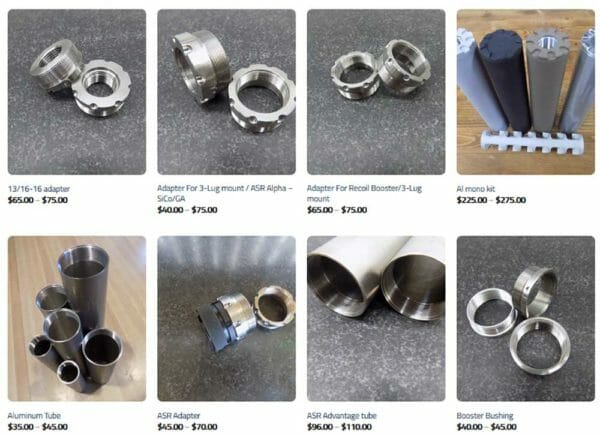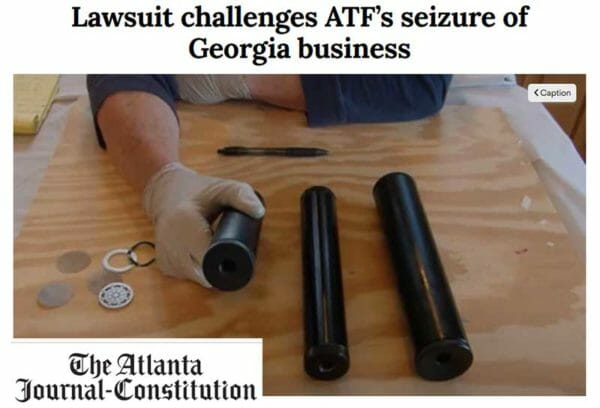
MARTINSBURG, WV –-(Ammoland.com)- Over the past year, the Bureau of Alcohol, Tobacco, Firearms, and Explosives (ATF) has been cracking down on solvent traps, and now a new leak provided to AmmoLand News by Gun Owners of America (GOA) shows that the ATF might be preparing more crackdowns on the popular items.
A solvent trap is designed to catch solvent from a firearm when the gun is being cleaned. The solvent trap attaches to the front of the gun by using a threaded barrel. The solvent collects at the bottom of the tube of the trap. Solvent traps have been popular amongst firearms enthusiasts that with possession of proper Licenses can convert the traps into fully functioning suppressors by drilling out internal plugs and the closed tubing end.
Owning a solvent trap is currently legal. Converting a solvent trap to a suppressor is also permitted if the builder engraves the tube, files an ATF form one, pays $200 to the ATF to receive a tax stamp.
“Solvent Traps” or “Fuel Filter Kits” are not regulated by the Gun Control Act (GCA) or the National Firearms Act (NFA), because and let us be honest here, we are talking about metal tubing. But that might be changing with the new rules expected this month. Certain senior members of the ATF leadership see solvent traps as a loophole to get around NFA restrictions on hearing protection devices, aka firearms silencers.
Solvent traps have been in the crosshairs for the past year. Multiple companies have been raided or visited by the ATF for selling solvent traps. Most of those companies that the ATF has visited were using Chinese imported parts, or end caps had dimples that guided the user on where to accurately drill out the holes in the correct locations.
Hawk Innovated Tech was one company that the ATF raided. Special Agents served a search warrant at Wayne Hawkins’ home, where he was selling solvent traps. The ATF seized all Hawkins’ inventory and claimed he was selling suppressors. The law enforcement agency also took $300,000 through civil forfeiture!?
Hawkins’ denies that he was selling silencers and claims that the items were just solvent traps, and according to the ATF, they do not regulate the item. The ATF did not file charges against Hawkins but kept the products and the cash. The Georgia man has now filed a lawsuit against the ATF.

The leak from insiders at ATF shows that field offices will no longer be allowed to answer questions about solvent traps. Deputy Assistant Director (IO) Megan A. Bennett emailed all field offices and informed them that any questions must be answered by the Firearms Industry Programs Branch (FIPB). Some believe that this change is to prepare for the transformation of the rule surrounding solvent traps. Insiders say the new rule will make the hollow tube itself to be a suppressor, which would outlaw solvent traps if put into place.
 AmmoLand News contacted Ms. Bennett to get a comment on the change of procedures. She referred AmmoLand News to the ATF’s Public Affairs Division. Acting Division Chief of Public Affairs, Erik Longnecker, stated to AmmoLand News that the ATF does not regulate Solvent traps. Mr. Longnecker didn’t respond to AmmoLand’s request to explain why the policy of answering questions about solvent traps has changed.
AmmoLand News contacted Ms. Bennett to get a comment on the change of procedures. She referred AmmoLand News to the ATF’s Public Affairs Division. Acting Division Chief of Public Affairs, Erik Longnecker, stated to AmmoLand News that the ATF does not regulate Solvent traps. Mr. Longnecker didn’t respond to AmmoLand’s request to explain why the policy of answering questions about solvent traps has changed.
The ATF is expected to unveil the new rule by the end of the month. Solvent traps are in the crosshairs, and the industry will take a hit. AmmoLand News will follow up once the rule is public.
About John Crump
John is a NRA instructor and a constitutional activist. John has written about firearms, interviewed people of all walks of life, and on the Constitution. John lives in Northern Virginia with his wife and sons and can be followed on Twitter at @crumpyss, or at www.crumpy.com.

